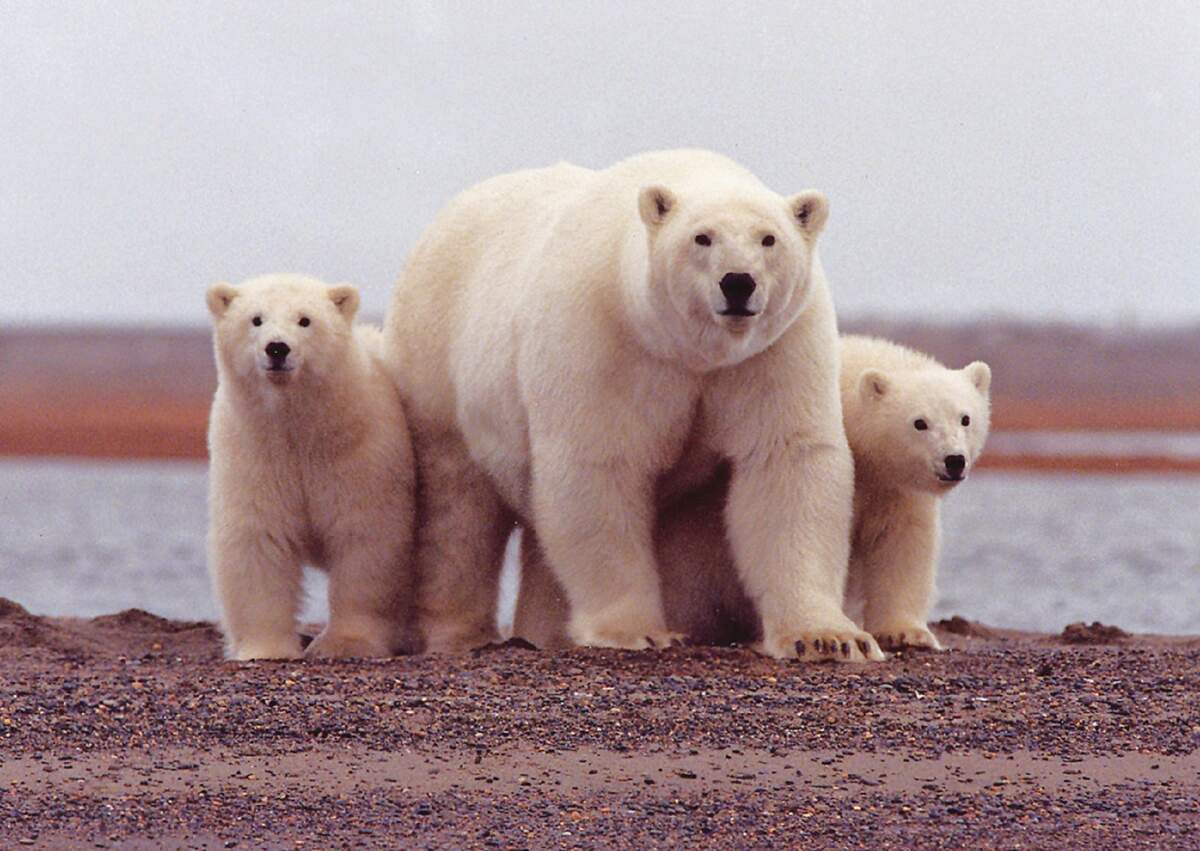

International Polar Bear Day
International Polar Bear Day, a day organized by Polar Bears International, draws attention to the threats that polar bears face in the warming Arctic, as a result of carbon dioxide and other greenhouse gases. The day is dedicated to reflecting on what can be done to help polar bears, and how carbon emissions can be reduced. Arctic warming has already had an effect. For example, in Western Hudson Bay there were about 1,200 polar bears in 1987, but by 2012 there were only 900. Climate change has lead to lower body weights in polar bears; lower body weight in females has affected their offspring, yielding smaller litters and causing fewer cubs to survive.
Warmer temperatures in the Arctic are detrimental to polar bears because they cause the loss of sea ice. Polar bears need sea ice to catch most of their prey—because that is where their prey resides. The number one food for polar bears is the ringed seal. It is high in fat—including beneficial omega-3 fatty acids—and calories, enough to keep polar bears healthy. Although ringed seals are the most prevalent, polar bears also eat bearded seals and other prey if it's available. In the summer, polar bears follow retreating ice, following their food source.
Seals cut ten to fifteen breathing holes in the ice during the fall, and keep them open throughout the winter. They come up for air through the holes every five to fifteen minutes, although sometimes they breathe from air pockets under the ice. Polar bears locate seals by scent and wait at hole openings for them to come up for air. Sometimes they wait for hours.
Polar bears are found in Alaska, Greenland, Norway, Russia, and Canada—where about 60 percent of them live. They have a larger range than other types of bears, often traveling large distances. Many also set their home ranges hundreds of miles away from where they grew up.
Scientists have come up with four different sea-ice regions in the Arctic. The Seasonal Ice Region is in the southern area of the polar bears' range, where the ice melts each summer. Polar bears that live here are most at risk for survival. The Hudson Bay is an example of a geographic area in this region. The Polar Bear Divergent Ice Region is an area where sea ice forms on the shore, and then retreats from the shore when it warms. As it retreats, polar bears must choose if they will stay on the mainland and fast, or swim long distances to find food. Polar bears that live in this region are at great risk. The Polar Bear Convergent Ice Region is an area where ice collects along the shore. Polar bears have a good supply of seals here, which helps them thrive in this region. But if there is not a reduction of emissions, the bears may be threatened in about 75 years. The Archipelago Ice Region is in the Canadian High Arctic and Greenland. The ice in this region stays throughout the summer, and polar bears are the least threatened in this region.
Polar bears are large in stature. They may grow up to nine feet in height (when standing on two legs) and may weigh 1,400 pounds. Their bodies are built for the cold. Fur covers skin and a layer of fat that can be over four inches thick. The fat keeps the bears warm in the water, as wet fur does not insulate very well. But the fur prevents the loss of heat while above water. Their paws may reach almost a foot across, and they walk at a rate of three or four miles an hour. They can run fast for short distances but will overheat if they do it for too long. Polar bears communicate by vocalizations, body language, and scent markings. If one bear wants to eat food that another bear has, they touch the other bear's nose to ask permission.
After eating, polar bears wash themselves using water and snow, and by licking themselves. They have similar sleep patterns to humans, sleeping seven to eight hours a night, and often taking naps. In spring and summer, they sleep more during the day, because the seals they eat are more active at night. Day and night do not have much importance in the Arctic though, as in the summer there are 24 hours of daylight, and in the winter there are 24 hours of darkness.
Between April and late June, males find mates, after following scented trails left by the footpads of females. Mating takes place on sea ice, but the eggs don't implant until the fall; this is called delayed implantation. The female builds a maternity den, and the bear cubs are often born in December. The mother and cubs remain in the den until March or early April, and the mother does not eat anything at this time. When they emerge, the mother brings them to sea ice and teaches them how to survive in the Arctic. The cubs live with their mother for about two and a half years.
How to Observe International Polar Bear Day
Polar Bears International suggests a few ways that the day can be observed. First, they suggest people take a pledge for action to be taken on the climate. They then recommend taking a "thermostat challenge" to the reduce carbon emissions that are aiding the endangerment of polar bears. The challenge can be done by turning down the thermostat for the day, and by buying a programmable thermostat or taking other measures to reduce carbon consumption year round. The less energy that is used from carbon-based fuels, the fewer carbon emissions there will be, which will slow global warming. Sea ice will then be saved, which will stop the decline of polar bear numbers because bears rely on the sea ice for hunting. Information and videos are often posted on the Polar Bears International Facebook page on International Polar Bear Day. Donations can also be made to protect sea ice. The day can also be spent by visiting a local zoo, which often hold special events for polar bears on the day.





















